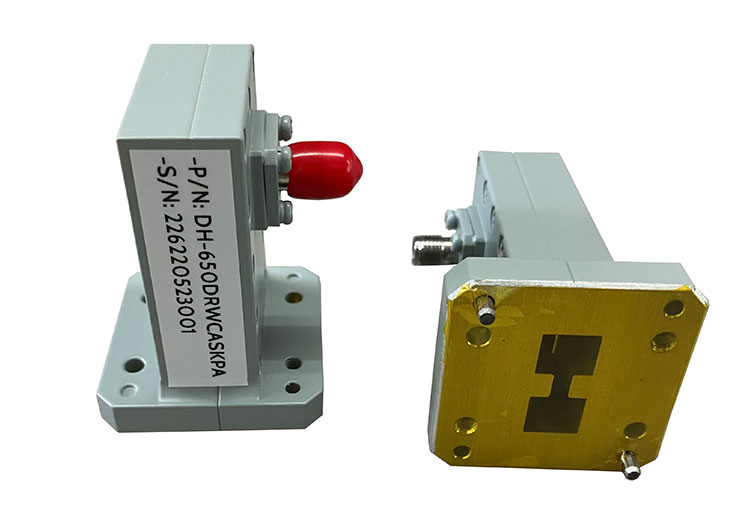Waveguide to coax adapter series products with wide frequency band, specifications varieties complete, voltage standing wave ratio and low insertion loss, frequency range: 0.3 ~ 110 GHz, bandwidth in the waveguide is 1.25 and 10% or less bandwidth in the low voltage standing wave ratio of 1.15 or less performance, According to the structure form and divided into Orthogonal structure(Right Angle), End - launch and high power type. Taking high power type as example below.

Flange type: Multiple types available - see Dolph Microwave Flanges page.
Finish: Corrosion protection plus black top coat.
For custom ridged waveguide with high quality and wide application, contact Dolph Microwave.
Waveguide to coax adapter connects waveguide transmission lines to coaxial transmission lines, and selecting the right one requires careful consideration of several factors:
1. Frequency Range:
The adapter's operational frequency range should encompass the frequencies used in your application. Choose one that covers your specific needs to ensure proper signal transmission.
2. Waveguide Type:
Different waveguide to coax adapters are compatible with different waveguide types, such as rectangular, circular, or double-ridged. Make sure the adapter matches the type of waveguide you're using.
3. Coaxial Connector Type:
Waveguide to coax adapters come with various coaxial connector types like SMA, N, BNC, etc. Select an adapter with a connector compatible with your coaxial cable.
4. Power Handling Capacity:
Each waveguide to coax adapter has a specific power handling capacity. Ensure it can handle the power levels present in your application to avoid damage or signal distortion.
5. Insertion Loss:
Insertion loss refers to the signal attenuation caused by the adapter. Choose an waveguide to coax adapter with minimal insertion loss to minimize signal degradation.
6. VSWR (Voltage Standing Wave Ratio):
VSWR measures the adapter's reflection characteristics. Lower VSWR indicates less signal reflection, so prioritize waveguide to coax adapters with low VSWR values.
7. Size and Weight:
The size and weight of the waveguide to coax adapter can impact installation and usage. Consider your application's needs and available space when making your choice.
8. Price:
Prices vary across waveguide to coax adapters. Consider both performance and budget constraints when making your selection.
Choosing the right waveguide to coax adapter
Start by defining your application's requirements, including frequency range, waveguide type, coaxial connector type, and power handling capacity.
Research different waveguide to coax adapters and compare their performance parameters based on your needs.
Choose a reputable supplier known for quality and reliability.
| Product model | Frequency (GHz) | VSWR | IL (dB) | Connect or type | Average power (W) | Flange | Material | Coated |
| DH‐84DRWHPCA5339 | 0.84‐2GHz waveguide to coax adapter | ≤1.50 | ≤0.5 | 5339‐K | 1000 | FP | AL | Oxidation |
| DH‐84DRWHPCAL29 | 0.84‐2GHz waveguide to coax adapter | ≤1.50 | ≤0.5 | L29‐K | 500 | FP | AL | Oxidation |
| DH‐84DRWHPCAL27 | 0.84‐2GHz waveguide to coax adapter | ≤1.50 | ≤0.5 | L27‐K | 500 | FP | AL | Oxidation |
| DH‐84DRWHPCAN | 0.84‐2GHz waveguide to coax adapter | ≤1.50 | ≤0.5 | N‐K | 300 | FP | AL | Oxidation |
| DH‐150DRWHPCAN | 1.5‐3.6GHz waveguide to coax adapter | ≤1.50 | ≤0.5 | N‐K | 300 | FP | AL | Oxidation |
| DH‐200DRWHPCAN | 2‐4.8GHz waveguide to coax adapter | ≤1.50 | ≤0.5 | N‐K | 300 | FP | AL | Oxidation |
| DH‐250DRWHPCAN | 2.6‐7.8GHz waveguide to coax adapter | ≤1.50 | ≤0.5 | N‐K | 300 | FP | AL | Oxidation |
| DH‐350DRWHPCAN | 3.5‐8.2GHz waveguide to coax adapter | ≤1.50 | ≤0.5 | N‐K | 200 | FP | AL | Oxidation |
| DH‐475DRWHPCAN | 4.75‐11GHz waveguide to coax adapter | ≤1.50 | ≤0.5 | N‐K | 200 | FP | AL | Oxidation |
| DH‐500DRWHPCAN | 5‐18GHz waveguide to coax adapter | ≤1.50 | ≤0.5 | N‐K | 200 | FP | AL | Oxidation |
| DH‐580DRWHPCAN | 5.8‐16GHz waveguide to coax adapter | ≤1.50 | ≤0.5 | N‐K | 200 | FP | AL | Oxidation |
| DH‐650DRWHPCAN | 6.5‐18GHz waveguide to coax adapter | ≤1.50 | ≤0.5 | N‐K | 200 | FP | CO | plated |
| DH‐750DRWHPCAN | 7.5‐18GHz waveguide to coax adapter | ≤1.50 | ≤0.5 | N‐K | 200 | FP | CO | plated |

Most of the signal transmission in the field of RF and microwave requires transmission lines for signal transmission, in which coaxial lines and waveguides are widely used to transmit microwave RF energy. There are huge differences in size, material, and transmission characteristics between the two transmission lines. Therefore, a double ridge waveguide to coaxial adapter is required to interconnect the two transmission lines.
The double-ridge waveguide to coaxial adapters provides broadband capability in a very compact form and allows transmission of power in either direction with very low reflection. It plays an indispensable role in various radar systems, precision guidance systems, and test equipment.
The double ridge waveguide to coaxial adapters is used to provide transmission between microwave devices and a coaxial component such as an attenuator, switches, or couplers. Thede microwave waveguide components are commonly used in satellite and terrestrial communications equipment.
Others you may be interested in: